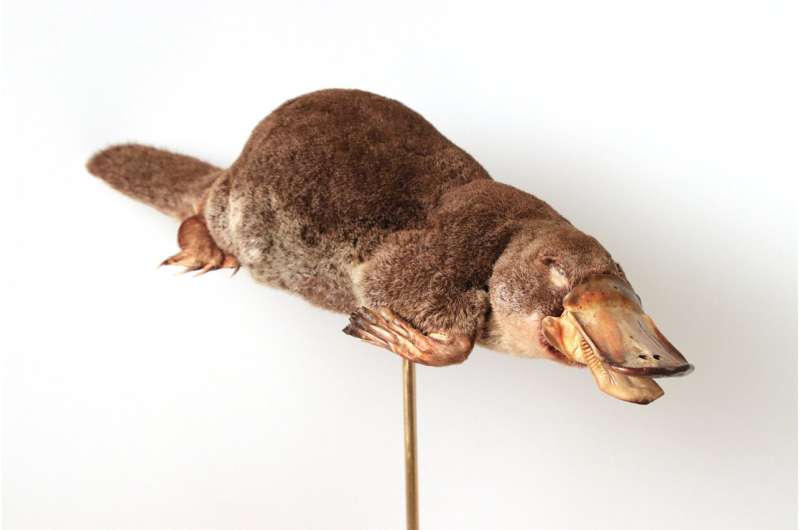Jars of tiny platypus and echidna specimens, collected in the late 1800s by the scientist William Caldwell, have been discovered in the stores of Cambridge’s University Museum of Zoology.
At the time of their collection, these specimens were key to proving that some mammals lay eggs—a fact that changed the course of scientific thinking and supported the theory of evolution.
This unique collection had not been catalogued by the museum, so until recently staff had been unaware of its existence. The exciting find was made when Jack Ashby, Assistant Director at the museum, was doing research for a new book on Australian mammals.
“It’s one thing to read the 19th-century announcements that platypuses and echidnas actually lay eggs. But to have the physical specimens here, tying us back to that discovery almost 150 years ago, is pretty amazing,” said Ashby.
He added, “I knew from experience that there isn’t a natural history collection on Earth that actually has a comprehensive catalog of everything in it, and I suspected that Caldwell’s specimens really ought to be here.” He was right: Three months after Ashby asked Collections Manager Mathew Lowe to keep an eye out, a small box of specimens was found in the museum with a note suggesting they were Caldwell’s. Ashby’s investigations confirmed this was indeed the case.
Until Europeans first encountered platypuses and echidnas in the 1790s, it had been assumed that all mammals give birth to live young. The question of whether some mammals lay eggs then became one of the biggest questions of 19th-century zoology, and hotly debated in scientific circles. The newly discovered collection of little jars represents the huge scientific endeavor that went into solving this mystery.
“In the nineteenth century, many conservative scientists didn’t want to believe that an egg-laying mammal could exist, because this would support the theory of evolution—the idea that one animal group was capable of changing into another,” said Ashby.
He added, “Lizards and frogs lay eggs, so the idea of a mammal laying eggs was dismissed by many people—I think they felt it was degrading to be related to animals that they considered ‘lower life forms.'”

Platypus specimen in the Cambridge University Museum of Zoology. © University of Cambridge
The newly discovered collection includes echidnas, platypuses and marsupials at varying life stages from fertilized egg to adolescence. Caldwell was the first to make complete collections of every life stage of these species—although not all of the specimens have been found in the museum.
For 85 years, European naturalists had been attempting to find proof that platypuses and echidnas lay eggs—including by asking Aboriginal Australians—but any results they sent home were ignored or dismissed.
William Caldwell was sent to Australia in 1883—with substantial financial backing from the University of Cambridge, the Royal Society and the British Government—to resolve the long-standing mystery.
In an extensive search, Caldwell collected around 1,400 specimens with the help of a large group of Aboriginal Australians. In 1884 the team eventually found an echidna with an egg in her pouch, and a platypus with one egg in her nest and another just about to be laid.
This was the definitive proof Caldwell had been looking for, and the news was sent around the world. The colonial scientific establishment was apparently only willing to accept this result now that it had been confirmed by “one of their own.”
Ashby says that over the last two centuries, scientists have consistently belittled Australian mammals by describing them as strange and inferior. He believes that this language continues to affect how we describe them today, and undermines efforts to conserve them.
“Platypuses and echidnas are not weird, primitive animals—as many historic accounts depict them—they are as evolved as anything else. It’s just that they’ve never stopped laying eggs,” he said, adding, “I think they’re absolutely amazing and definitely worth valuing.”
The quill-covered echidnas are the most widespread mammal in Australia. They cover the whole continent and have adapted to live in all climates—from snow-covered mountains through to the driest deserts.
Platypuses are one of the only mammals that can detect electricity, and one of the only mammals to produce venom. With a tail like a beaver, a flat bill, and webbed feet like a duck, when the first specimens were brought to Europe people thought they were fakes that had been sewn together.
Both platypuses and echidnas have a unique combination of traits that 19th-century scientists thought should only exist individually in either mammals, reptiles or birds. This made them central to debates around evolution.
Ashby’s new book, “Platypus Matters: The Extraordinary Story of Australian Mammals,” is published in the UK on 12 May, 2022 by HarperCollins.
Provided by
University of Cambridge
Citation:
Museum discovers 150-year-old platypus and echidna specimens that proved some mammals lay eggs (2022, May 11)


